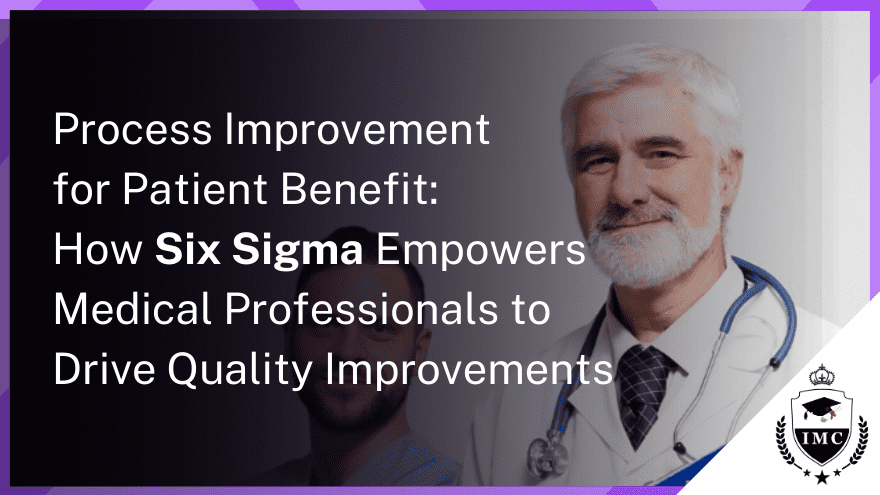Have you ever experienced endless waits and confusion at a hospital and blamed the doctors and nurses? In reality, medical professionals are caught in inefficient processes outside their control. Healthcare faces immense pressure to improve care and cut costs. Many leading hospitals have found answers in Six Sigma, a data-driven methodology to systematically remove waste and improve processes. Originating in manufacturing, Six Sigma provides a proven framework for healthcare organizations to streamline operations and empower medical professionals. In this article, I’ll explore how Six Sigma works, its benefits like faster service, shorter waits, and better coordinated care, and real examples of hospitals saving millions through its use. A key benefit is how Six Sigma promotes critical thinking and data-guided decisions among medical professionals to drive continuous improvement. If you’re frustrated with healthcare, Six Sigma offers hope through its patient-focused, process excellence approach. Let’s examine how it transforms hospital quality and efficiency.
What is Six Sigma?
Six Sigma is a quality management methodology developed in the 1980s by Motorola. It utilizes statistical analysis and a rigorous problem-solving approach called DMAIC (Define, Measure, Analyze, Improve, Control). The overarching goal is to identify and eliminate defects or errors in processes. Specifically, Six Sigma seeks to achieve a defect level below 3.4 defects per million opportunities. This near-perfect rate of quality is equivalent to 99.9997% accuracy. While this level of perfection may seem unattainable, Six Sigma provides the tools and techniques to systematically work towards it.
Key Principles of Six Sigma
Focus on patient needs - Six Sigma starts with understanding patient requirements and designing care around them. This prevents wasted effort on processes that don't add value for patients.
Data-driven decisions - Six Sigma relies on collecting and analyzing data to find the root causes of problems. This takes decision making out of personal opinions and focuses it on facts.
Statistical analysis - Statistical tools help measure current performance, identify issues, and predict future outcomes. This allows for preventive action rather than reactive firefighting.
Rigorous project methodology - The DMAIC approach provides a structured roadmap from problem definition to verified solution. This builds process discipline and consistency.
How Six Sigma Empowers Medical Professionals:
Provides data-driven insights: Six Sigma equips medical professionals with the tools and techniques to analyze data and identify the root causes of inefficiencies and errors in their daily routines.
Empowers participation in improvement initiatives: Six Sigma encourages medical professionals to actively contribute their expertise and experience to identify and design solutions for improvement projects.
Develops critical thinking and problem-solving skills: By engaging in the Six Sigma methodology, medical professionals hone their ability to analyze data, identify problems, and develop effective solutions, enhancing their overall effectiveness.
Promotes a culture of continuous improvement: Six Sigma fosters a collaborative environment where medical professionals work together to identify opportunities for improvement, leading to a culture of continuous learning and innovation within the hospital.
Benefits of Six Sigma for Hospitals
Adopting Six Sigma can transform hospital operations in many positive ways:
Improved patient care
At its core, Six Sigma improves patient care by focusing on patient needs and reducing medical errors. This supports better health outcomes and higher patient satisfaction.
Streamlined processes
By eliminating wasted steps and optimizing flow, Six Sigma smooths out hospital workflows. This reduces patient wait times, speeds up lab turnaround, and improves staff efficiency.
Cost reduction
Process improvements and reduced errors decrease costs associated with waste, readmissions, and additional treatment. Hospitals can save millions of dollars through Six Sigma.
Data-driven culture
Six Sigma instills data-driven decision making at all levels of an organization. This builds a culture of continuous improvement guided by facts rather than gut feelings.
Quality benchmarking
The statistical process control tools in Six Sigma facilitate measuring performance across the organization. This enables benchmarking against goals and other hospitals.
Regulatory compliance
Six Sigma helps standardize processes to meet regulatory requirements and accreditation standards. This reduces compliance risk.
Staff engagement
Frontline staff are involved in Six Sigma projects that make their jobs easier. Seeing their input drive real improvement boosts engagement and retention.
Six Sigma in Action at Hospitals
Many leading hospitals have adopted Six Sigma to great effect:
Mayo Clinic saved over $75 million by applying Six Sigma to reduce appointment lead times and improve utilization of operating rooms.
Johns Hopkins Hospital used Six Sigma to decrease patient transport times, leading to improved care coordination and reduced transport costs.
Mount Sinai Medical Center improved pneumonia testing turnaround time from 52 hours to just 4 hours using SixSigma, leading to faster treatment and better outcomes.
Children's Hospital & Research Center Oakland cut the time tore-sterilize surgical trays from 24 hours to less than 2 hours,improving OR efficiency.
Six Sigma Training and Certification Levels
White Belt - Hospital staff with basic Six Sigma training. They have an awareness of Six Sigma principles and participate on project teams.
Six Sigma Yellow Belt Certification - Hospital staff with intermediate Six Sigma training. They have skills to collect and analyze data for improvement projects. They may participate in or lead small scale projects.
Six Sigma Green Belt Certification- Hospital specialists and leaders with advanced Six Sigma expertise. They lead medium-sized improvement projects utilizing DMAIC methodology. Examples could include nurses, lab technicians, department managers.
Six Sigma Black Belt Certification- Full-time Six Sigma experts that train and mentor others on Six Sigma. They lead complex, high-impact improvement projects across departments. Black belts devote all their time to Six Sigma.
Six Sigma Master Black Belt Certification - Highly experienced Black Belts who train and coach other belts. They are responsible for strategic deployment of Six Sigma and mentoring Black Belts. Top hospital executives are ideal for this role.
Summary:
How Six Sigma Empowers Medical Professionals explores how the data-driven Six Sigma methodology can transform quality and efficiency in healthcare. The article outlines the principles of Six Sigma and its benefits, like improved patient care, streamlined processes, cost reduction, quality benchmarking, and staff engagement. It provides examples of leading hospitals that have successfully adopted Six Sigma resulting in millions in savings and shorter wait times. A key benefit highlighted is how Six Sigma empowers medical professionals by promoting data-based critical thinking, developing problem-solving skills, and creating a culture of continuous improvement. The article makes a strong case for hospitals to implement Six Sigma to systematically improve patient outcomes and operational excellence.






